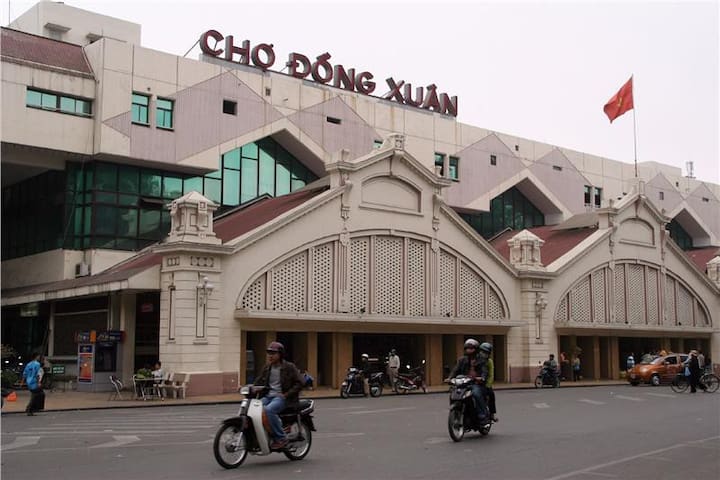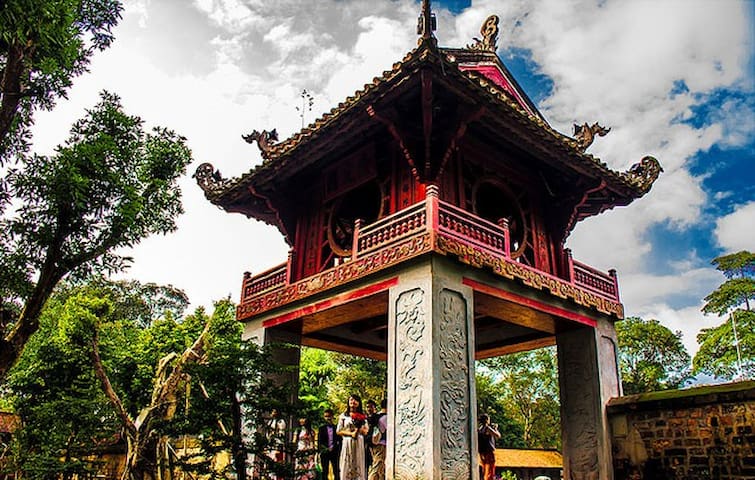A View of Hanoi
Following is a list of sight-seeing recommendations around Hanoi. Please try if you want to experience the authentically cultural and historical aura of the one-thousand-year-old capital of Vietnam. We also provide consultancy for Hanoi tour service if you are insterested.
A historic pagoda with more than 1500 history. This pagoda is an architectural, religious and historical incarnation of Vietnam in particular and Eastern culture in general. Tran Quoc pagoda possesses an elegant and tranquil beauty as well as reputation for religious and spiritual values.
92 yerel halk öneriyor
Chùa Trấn Quốc - Thanh Niên
Đường Thanh NiênA historic pagoda with more than 1500 history. This pagoda is an architectural, religious and historical incarnation of Vietnam in particular and Eastern culture in general. Tran Quoc pagoda possesses an elegant and tranquil beauty as well as reputation for religious and spiritual values.
St. Joseph's Cathedral (French: Cathédrale Saint-Joseph) is a church on Nha Chung Street in the Hoàn Kiếm District of Hanoi, Vietnam. Its a late 19th-century Gothic Revival (Neo-Gothic style) church that serves as the cathedral of the Roman Catholic Archdiocese of Hanoi to nearly 4 million Catholics in the country. The cathedral was named after Joseph, the patron saint of Vietnam and Indochina.
Construction began in 1886, with the architectural style described as resembling Notre Dame de Paris. The church was one of the first structures built by the French colonial government in Indochina when it opened in December 1886. It is the oldest church in Hanoi.
The cathedral conducts mass several times during the day. For Sunday evening mass at 6:00 PM, large crowds spill out into the streets. The prayer hymns are broadcast and Catholics who are unable to enter the cathedral congregate in the street and listen to hymns.
209 yerel halk öneriyor
St. Joseph Katedrali
40 Nhà ChungSt. Joseph's Cathedral (French: Cathédrale Saint-Joseph) is a church on Nha Chung Street in the Hoàn Kiếm District of Hanoi, Vietnam. Its a late 19th-century Gothic Revival (Neo-Gothic style) church that serves as the cathedral of the Roman Catholic Archdiocese of Hanoi to nearly 4 million Catholics in the country. The cathedral was named after Joseph, the patron saint of Vietnam and Indochina.
Construction began in 1886, with the architectural style described as resembling Notre Dame de Paris. The church was one of the first structures built by the French colonial government in Indochina when it opened in December 1886. It is the oldest church in Hanoi.
The cathedral conducts mass several times during the day. For Sunday evening mass at 6:00 PM, large crowds spill out into the streets. The prayer hymns are broadcast and Catholics who are unable to enter the cathedral congregate in the street and listen to hymns.
Hoan Kiem Lake , meaning "Lake of the Returned Sword" or "Lake of the Restored Sword"), also known as Hồ Gươm (Sword Lake), is a fresh water lake, measuring some 12 ha in the historical center of Hanoi, the capital city of Vietnam.
In the past, the lake was variously name "Luc Thuy Lake" (meaning "Green Water Lake" - aptly named for the water's color) or "Thuy Quan Lake" (meaning "Mariner's Lake"). The lake is one of the major scenic spots in the city and serves as a focal point for its public life.
513 yerel halk öneriyor
Hoàn Kiếm Gölü
Hoan Kiem Lake , meaning "Lake of the Returned Sword" or "Lake of the Restored Sword"), also known as Hồ Gươm (Sword Lake), is a fresh water lake, measuring some 12 ha in the historical center of Hanoi, the capital city of Vietnam.
In the past, the lake was variously name "Luc Thuy Lake" (meaning "Green Water Lake" - aptly named for the water's color) or "Thuy Quan Lake" (meaning "Mariner's Lake"). The lake is one of the major scenic spots in the city and serves as a focal point for its public life.
The Long Bien Bridge was constructed from 1989 to 1902 during French’s occupation of the country. Though the bridge was designed by French, it was built directly by Vietnamese workers with indigenous construction materials like woods from Phu Tho, Yen Bai, Thanh Hoa province, cement from Hai Phong, Long Tho lime from Hue.
85 yerel halk öneriyor
Long Biênbrug
The Long Bien Bridge was constructed from 1989 to 1902 during French’s occupation of the country. Though the bridge was designed by French, it was built directly by Vietnamese workers with indigenous construction materials like woods from Phu Tho, Yen Bai, Thanh Hoa province, cement from Hai Phong, Long Tho lime from Hue.
Đồng Xuân Market (Springfield Market) is a market in the center district Hoàn Kiếm of Hanoi, Vietnam. Originally built by the French administration in 1889, Đồng Xuân Market has been renovated several times with the latest in 1994 after a fire which almost destroyed the market. Nowadays, Đồng Xuân Market is the largest covered market of Hanoi where the wholesale traders sell everything from clothes, household goods to food stuffs.
147 yerel halk öneriyor
Dong Xuan Pazarı
Đồng Xuân Market (Springfield Market) is a market in the center district Hoàn Kiếm of Hanoi, Vietnam. Originally built by the French administration in 1889, Đồng Xuân Market has been renovated several times with the latest in 1994 after a fire which almost destroyed the market. Nowadays, Đồng Xuân Market is the largest covered market of Hanoi where the wholesale traders sell everything from clothes, household goods to food stuffs.
Ham Long Church is a Roman Catholic church in the center district Hoan Kiem of Hanoi. The church was built at the end of the 19th century on an old street named Hàm Long from which Ham Long Church was called. Today, Ham Long Church is one of the three major churches of Hanoi, together with Cua Bac Church and Saint Joseph Cathedral.
7 yerel halk öneriyor
St. Anthony Ham Long Kilisesi
21 P.Hàm LongHam Long Church is a Roman Catholic church in the center district Hoan Kiem of Hanoi. The church was built at the end of the 19th century on an old street named Hàm Long from which Ham Long Church was called. Today, Ham Long Church is one of the three major churches of Hanoi, together with Cua Bac Church and Saint Joseph Cathedral.
Spanning almost 4km along the Song Hong dyke, from its terminus at the Long Bien Bridge, this mural project holds the Guinness World Record for being the largest ceramic mosaic on the planet. The colourful mural lines busy roads, uses ceramics produced at nearby Bat Trang and depicts different periods in Vietnam's history. Both local and international artists commenced work on the project in 2007, completed in 2010 for Hanoi's 1000th-birthday celebrations.
7 yerel halk öneriyor
Hanoi Ceramic Mosaic Mural
Phố Tân ẤpSpanning almost 4km along the Song Hong dyke, from its terminus at the Long Bien Bridge, this mural project holds the Guinness World Record for being the largest ceramic mosaic on the planet. The colourful mural lines busy roads, uses ceramics produced at nearby Bat Trang and depicts different periods in Vietnam's history. Both local and international artists commenced work on the project in 2007, completed in 2010 for Hanoi's 1000th-birthday celebrations.
Tourist Attraction
The Temple of Literature or Temple of Culture is a Temple of Confucius in Hanoi, northern Vietnam. The temple hosts the Imperial Academy, Vietnam's first national university. The temple was built in 1070 at the time of Emperor Lý Thánh Tông. It is one of several temples in Vietnam which is dedicated to Confucius, sages and scholars. The temple is located to the south of the Imperial Citadel of Thăng Long. The various pavilions, halls, statues and stelae of doctors are places where offering ceremonies, study sessions and the strict exams of the Đại Việt took place. The temple is featured on the back of the 100,000 Vietnamese đồng banknote. Just before the Vietnamese New Year celebration Tết, calligraphists will assemble outside the temple and write wishes in Hán characters. The art works are given away as gifts or are used as home decorations for special occasions.
246 yerel halk öneriyor
Temple Of Literature
Temple of LiteratureThe Temple of Literature or Temple of Culture is a Temple of Confucius in Hanoi, northern Vietnam. The temple hosts the Imperial Academy, Vietnam's first national university. The temple was built in 1070 at the time of Emperor Lý Thánh Tông. It is one of several temples in Vietnam which is dedicated to Confucius, sages and scholars. The temple is located to the south of the Imperial Citadel of Thăng Long. The various pavilions, halls, statues and stelae of doctors are places where offering ceremonies, study sessions and the strict exams of the Đại Việt took place. The temple is featured on the back of the 100,000 Vietnamese đồng banknote. Just before the Vietnamese New Year celebration Tết, calligraphists will assemble outside the temple and write wishes in Hán characters. The art works are given away as gifts or are used as home decorations for special occasions.
This thought-provoking site is all that remains of the former Hoa Lo Prison, ironically nicknamed the ‘Hanoi Hilton’ by US prisoners of war during the American War. Most exhibits relate to the prison’s use up to the mid-1950s, focusing on the Vietnamese struggle for independence from France. A gruesome relic is the ominous French guillotine, used to behead Vietnamese revolutionaries. There are also displays focusing on the American pilots who were incarcerated at Hoa Lo during the American War.
212 yerel halk öneriyor
Hoa Lo Prison
1 Hoả LòThis thought-provoking site is all that remains of the former Hoa Lo Prison, ironically nicknamed the ‘Hanoi Hilton’ by US prisoners of war during the American War. Most exhibits relate to the prison’s use up to the mid-1950s, focusing on the Vietnamese struggle for independence from France. A gruesome relic is the ominous French guillotine, used to behead Vietnamese revolutionaries. There are also displays focusing on the American pilots who were incarcerated at Hoa Lo during the American War.
The Imperial Citadel of Thang Long, is an intriguing relic of Vietnam’s history and, signifying its historical and cultural importance, was made a UNESCO World Heritage Site in 2010. Also known as the Hanoi Citadel, many artefacts and items dating back to between the 6th and 20th centuries were excavated in 2004, including foundations of old palaces, ancient roads, ponds and wells.
114 yerel halk öneriyor
Thăng Long İmparatorluk Kalesi
19c Hoàng DiệuThe Imperial Citadel of Thang Long, is an intriguing relic of Vietnam’s history and, signifying its historical and cultural importance, was made a UNESCO World Heritage Site in 2010. Also known as the Hanoi Citadel, many artefacts and items dating back to between the 6th and 20th centuries were excavated in 2004, including foundations of old palaces, ancient roads, ponds and wells.
Rising from one pillar in the centre of an elegantly square shaped lotus pond, The One Pillar Pagoda is said to represent a lotus flower growing up out of the water. Built between the years of 1028 and1054 during the reign of Emperor Ly Thai Tong of the Ly Dynasty, the One Pillar Pagoda is one of Vietnam’s most iconic temples.
88 yerel halk öneriyor
One Pillar Pagoda
phố Chùa Một CộtRising from one pillar in the centre of an elegantly square shaped lotus pond, The One Pillar Pagoda is said to represent a lotus flower growing up out of the water. Built between the years of 1028 and1054 during the reign of Emperor Ly Thai Tong of the Ly Dynasty, the One Pillar Pagoda is one of Vietnam’s most iconic temples.







